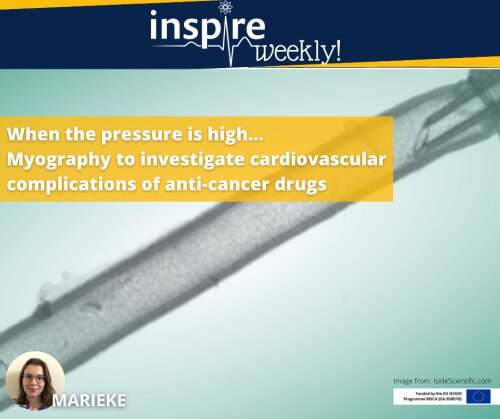12/05/2021 - Marieke (ESR #11)

In this image, you can see a blood vessel segment mounted on two glass micro-cannulae. In this set-up, the environment of the vessel is maintained under physiologically relevant conditions. Acidity and temperature of the fluid around the vessel can be adjusted and the pressure both inside and outside of the vessel can be regulated. After the vessel is secured and the environment is prepared, this technique, called pressure myography, allows measurement of dynamic changes in the diameter of the vessel.1 Drugs can be tested, either in the bathing solution or intra-luminally; their vasoactive properties may cause a contraction of the vessel, so the diameter of the vessel segment will decrease, or cause a vasodilation, meaning the diameter will increase.
Vascular Endothelial Growth Factor (VEGF) inhibitors are powerful drugs to stop tumour growth, but they are known to cause an elevated blood pressure in patients taking them.2 During my PhD, I will study the mechanisms by which these VEGF-inhibitors might change the diameter of the isolated vessel. If these drugs cause a decrease in the vessel diameter, this could be an explanation for the increased blood pressure in patients. In this way, our knowledge on the mechanism behind the blood pressure raise will develop further, giving us more information on how to avoid this in the future.
References:
- Schjørring, O. L., Carlsson, R. & Simonsen, U. Pressure Myography to Study the Function and Structure of Isolated Small Arteries. Methods in Molecular Biology, vol. 1339, 277–285 (2015).
- Ferrara, N. & Adamis, A. P. Ten years of anti-vascular endothelial growth factor therapy. Nat. Rev. Drug Discov. 15, 385–403 (2016).